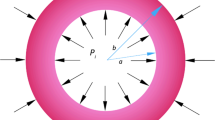Abstract
This paper describes a numerical model developed for the computation of creep damages in a thick-walled sphere subjected to an internal pressure and a thermal gradient. The model predicts the creep damage histories during the life of the sphere, owing to variations in stresses with time and through-thickness variations. The creep damage fraction is based on the Robinson’s linear life fraction damage rule, which has been incorporated in a nonlinear time-dependent stress analysis. Following the stress histories, the effective stress histories are obtained and the creep damages are calculated and summed during the life of the sphere. The material long-term creep properties up to the rupture and creep rupture data are defined by the Θ projection concept [1]. The damage histories up to 38 years are calculated and the results show that the maximum damages are always located at the inner surface of the sphere, while the outer surface of the vessel sustains minimum damages.
Similar content being viewed by others
References
R. W. Evans, J. D. Parker and B. Wilsher, The theta projection concept a model based approach to design and life extention of engineering plant. Int. J. Pres. Ves. and Piping, 50 (1992) 60–147.
C. A. Jaske, Life assessment of hot reheat steam pipe. ASME J. Pres. Ves. Technology, 112 (1990) 7–20.
F. A. Simson and C. A Jaske, a Computational model for predicting the life of tubes used in petrochemical heater service. ASME J. Pres. Ves. Technology, 107(1985) 39–46.
A. Loghman and M. A Wahab, Creep damage simulation of thick-walled tubes using the theta projection concept, Int. J. Press. Ves. & Piping 67(1996) 111–105.
R. W. Evans and B. Wilshire, Creep of Metals and Alloys. Inst. of metals, London, (1985).
A. Mendelson, Plasticity: Theory and Application, The Macmillan Company, New York, USA, (1968).
Author information
Authors and Affiliations
Corresponding author
Additional information
This paper was recommended for publication in revised form by Associate Editor Youngseog Lee
Abbas Loghman received his BS degree from Sharif University of Technology, Tehran, Iran, in 1980, He then received his MS degree from the Amirkabir University of Technology, Tehran, Iran, in 1986 and his PhD degree from the University of Adelaide, South Australia, in 1995. Dr. Loghman is an Assistant Professor in the Mechanical Engineering Department of Kashan University, Kashan, Iran. His current research interests are creep and creep-fatigue life assessment of pressure vessels.
Nader Shokouhi received his BS degree from Kashan University, Iran, in 2002 and his MS degree from the Amirkabir University of Technology, Iran, in 2004. He is currently working towards his PhD degree in the Department of Mechanical Engineering, Sharif University of Technology, Iran. His current research interests are in rail vehicle dynamics modeling. He is Director of the Research and Development Department in Irankhodro Rail Transport Industries Company (IRICO).
Rights and permissions
About this article
Cite this article
Loghman, A., Shokouhi, N. Creep damage evaluation of thick-walled spheres using a long-term creep constitutive model. J Mech Sci Technol 23, 2577–2582 (2009). https://doi.org/10.1007/s12206-009-0631-x
Received:
Revised:
Accepted:
Published:
Issue Date:
DOI: https://doi.org/10.1007/s12206-009-0631-x




